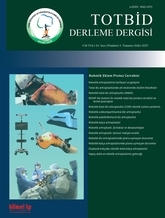
The MAKO system is an image-based, semi-active robotic arm. All planning and measurements are performed on a real three-dimensional image of the knee created from a computed tomography scan of the whole extremity. Extension and flexion gaps can be assessed independently on the medial and lateral side using dynamic measurements. The desired coronal alignment can be achieved by making small adjustments of the component positions within safe boundaries. Both systematic and personalized alignment strategies can be implemented with the robotic system, however, functional alignment, which takes into account both bone resections and soft tissue laxity is preferred. Robotic total knee arthroplasty leads to less bone resections, more accurate implant sizing and positioning, better extremity alignment and soft tissue balance compared to manual arthroplasty. Avoidance of the intra-medullary canal and ligament releases leads to less blood loss and improved patient comfort during the early post-operative period. No superiority of robotics in clinical outcomes and survivorship have been shown compared to manual total knee arthroplasty if mechanical alignment is the goal. However, better clinical scores and patient satisfaction can be achieved using functional alignment strategies and robotics. The learning curve is around 10 cases. Increased operative times for beginners, the additional radiation exposure needed for the computed tomography scan and the risk of fractures originating from the holes of the Schanz screws used to fix the robotic arrays to the bone are issues and complications specific to robotic arthroplasty.